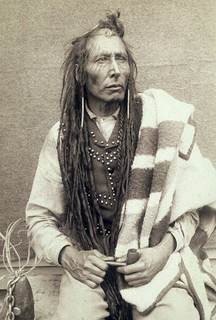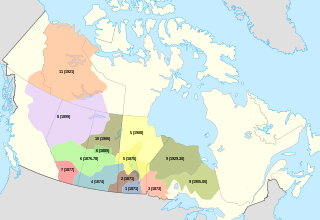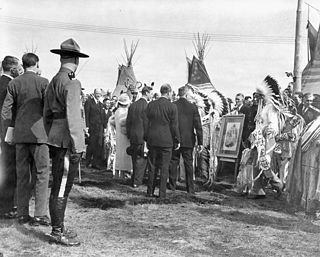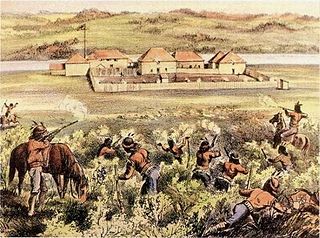Plains Cree may refer to:
Plains Cree may refer to:
The Cree are one of the largest groups of First Nations in North America.

The Algonquian languages are a subfamily of American indigenous languages that include most languages in the Algic language family. The name of the Algonquian language family is distinguished from the orthographically similar Algonquin dialect of the indigenous Ojibwe language (Chippewa), which is a senior member of the Algonquian language family. The term Algonquin has been suggested to derive from the Maliseet word elakómkwik, "they are our relatives/allies". A number of Algonquian languages, like many other Native American languages, are now extinct.

Cree is a dialect continuum of Algonquian languages spoken by approximately 117,000 people across Canada, from the Northwest Territories to Alberta to Labrador. If considered one language, it is the aboriginal language with the highest number of speakers in Canada. The only region where Cree has any official status is in the Northwest Territories, alongside eight other aboriginal languages. There, Cree is spoken mainly in Fort Smith and Hay River.

The Saulteaux, otherwise known as the Plains Ojibwe, are a First Nations band government in Ontario, Manitoba, Saskatchewan, Alberta and British Columbia, Canada. They are a branch of the Ojibwe who pushed west. They formed a mixed culture of woodlands and plains Indigenous customs and traditions.

Pîhtokahanapiwiyin, also known as Poundmaker, was a Plains Cree chief known as a peacemaker and defender of his people, the Poundmaker Cree Nation. His name denotes his special craft at leading buffalo into buffalo pounds (enclosures) for harvest.

Canadian syllabic writing, or simply syllabics, is a family of abugidas created by James Evans to write a number of indigenous Canadian languages of the Algonquian, Inuit, and (formerly) Athabaskan language families, which had no formal writing system previously. They are valued for their distinctiveness from the Latin script of the dominant languages and for the ease with which literacy can be achieved; indeed, by the late 19th century the Cree had achieved what may have been one of the highest rates of literacy in the world.

Western Cree syllabics are a variant of Canadian Aboriginal syllabics used to write Plains Cree, Woods Cree and the western dialects of Swampy Cree. It is used for all Cree dialects west of approximately the Manitoba–Ontario border in Canada, as opposed to Eastern Cree syllabics. It is also occasionally used by a few Cree speakers in the United States.

The Assiniboine or Assiniboin people, also known as the Hohe and known by the endonym Nakota, are a First Nations/Native American people originally from the Northern Great Plains of North America.
First Nations in Alberta are a group of people who live in the Canadian province of Alberta. The First Nations are peoples recognized as Indigenous peoples or Plains Indians in Canada excluding the Inuit and the Métis. According to the 2011 Census, a population of 116,670 Albertans self-identified as First Nations. Specifically there were 96,730 First Nations people with registered Indian Status and 19,945 First Nations people without registered Indian Status. Alberta has the third largest First Nations population among the provinces and territories. From this total population, 47.3% of the population lives on an Indian reserve and the other 52.7% live in urban centres. According to the 2011 Census, the First Nations population in Edmonton totalled at 31,780, which is the second highest for any city in Canada. The First Nations population in Calgary, in reference to the 2011 Census, totalled at 17,040. There are 48 First Nations or "bands" in Alberta, belonging to nine different ethnic groups or "tribes" based on their ancestral languages.

Treaty 6 is the sixth of the numbered treaties that were signed by the Canadian Crown and various First Nations between 1871 and 1877. It is one of a total of 11 numbered treaties signed between the Canadian Crown and First Nations. Specifically, Treaty 6 is an agreement between the Crown and the Plains and Woods Cree, Assiniboine, and other band governments at Fort Carlton and Fort Pitt. Key figures, representing the Crown, involved in the negotiations were Alexander Morris, Lieutenant Governor of the North-West Territories; James McKay, The Minister of Agriculture for Manitoba; and W.J. Christie, the Chief Factor of the Hudson's Bay Company. Chief Mistawasis and Chief Ahtahkakoop represented the Carlton Cree.

Enoch Cree Nation 135, previously known as Stony Plain No. 135, is an Indian reserve of the Enoch Cree Nation in Alberta. It is adjacent to the City of Edmonton to the east and Parkland County to the north, west, and south. The postal address of the reserve is Enoch, Alberta.

Plains Cree is a dialect of the Algonquian language, Cree, which is the most populous Canadian indigenous language. Plains Cree is considered a dialect of the Cree-Montagnais language or a dialect of the Cree language that is distinct from the Montagnais language. Plains Cree is one of five main dialects of Cree in this second sense, along with Woods Cree, Swampy Cree, Moose Cree, and Atikamekw. Although no single dialect of Cree is favored over another, Plains Cree is the one that is the most widely used. Out of the 116,500 speakers of the Cree language, the Plains Cree dialect is spoken by about 34,000 people primarily in Saskatchewan and Alberta but also in Manitoba and Montana.

The Enoch Cree Nation #440 is a First Nations band government in Alberta, Canada. Members of the Nation are of Cree ancestry and speak the Plains Cree dialect of the Cree language group. The band was a signatory of Treaty Six and is a current member of the Confederacy of Treaty Six First Nations.

The Nakoda are an Indigenous people in Western Canada and, originally, the United States.

Fort Pitt was a fort built in 1830 by the Hudson's Bay Company (HBC) that also served as a trading post on the North Saskatchewan River in Rupert's Land. It was built at the direction of Chief Factor John Rowand, previously of Fort Edmonton, in order to trade for bison hides, meat and pemmican. Pemmican, dried buffalo meat, was required as provisions for HBC's northern trading posts.
The Saāwithiniwak or Woodland Cree, are a Cree people, calling themselves Nîhithaw in their own dialect of the language. They are the largest indigenous group in northern Alberta and are an Algonquian people. Prior to the 18th century, their territory extended west of Hudson Bay, as far north as Churchill. Although in western Northern Saskatchewan and Manitoba, by the 18th century, they acted as middlemen in trade with western tribes. After acquiring guns through trade, they greatly expanded their territory and drove other tribes further west and north.

The Red Pheasant Cree Nation is a Plains Cree First Nations band government in the Canadian province of Saskatchewan. The band's sole reserve, Red Pheasant 108, is 33 km south of North Battleford.
Woods Cree is an autochthonous language spoken in Northern Manitoba, Northern Saskatchewan and Northern Alberta, Canada. It is part of the Cree-Montagnais-Naskapi dialect continuum. The dialect continuum has around 116,000 speakers; the exact population of Woods Cree speakers is unknown, estimated between 2,600 and 35,000.
The Iron Confederacy was a political and military alliance of Plains Indians of what is now Western Canada and the northern United States. This confederacy included various individual bands that formed political, hunting and military alliances in defense against common enemies. The ethnic groups that made up the Confederacy were the branches of the Cree that moved onto the Great Plains around 1740, the Saulteaux, the Nakoda or Stoney people also called Pwat or Assiniboine, and the Metis and Iroquois. The Confederacy rose to predominance on the northern Plains during the height of the North American fur trade when they operated as middlemen controlling the flow of European goods, particularly guns and ammunition, to other Indigenous nations, and the flow of furs to the Hudson's Bay Company (HBC) and North West Company (NWC) trading posts. Its peoples later also played a major part in the bison (buffalo) hunt, and the pemmican trade. The decline of the fur trade and the collapse of the bison herds sapped the power of the Confederacy after the 1860s, and it could no longer act as a barrier to U.S. and Canadian expansion.
Tootoosis is a surname of Plains Cree origin.